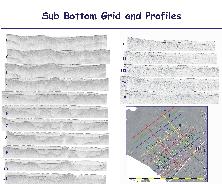| Topography, Bathymetry, BackScatter and Sub-bottom Profile Data sets. | |
| A Digital Terrrain Model (DTM)
of the topography was created from Service New Brunswick and United States
Geological Survey data. This detailed digital terrain model (DTM) of
the topography revealed the obvious and dominant northwest-southeast trending
fabric. This fabric is not related to the tectonics of the region but to glacial
morphology and glacial deposits. The southeasterly movements of
the ice over the bedrock and the glacial detritus in the form of roche moutonee,
drumlins, moraines, eskers and outwash has produced a very pronounced north
west- southeast fabric. The bathymetry and backscatter were gathered over a 10 year period in four separate surveys. The 1992 and 1995 surveys, by the Canadian Hydrographic Service onboard the CSS Frederick G. Creed with an EM1000, 100kHz multibeam sonar system. In 2002 the OMG/CHS launch CSL Heron with an EM3000S 300kHz multibeam sonar system surveyed the environs of St. Andrews and Navy Island. Also in 2002, the CHS launch, the CSL Plover filled in a data gap using the EM3000S system. The sub bottom profile data was gathered in 2002, using a 3.5kHz transducer and a Knudsen 320 M system. |
|
Further when the bathymetry of Passamaquoddy Bay is added to this DTM we see that the seafloor bathymetry, structure, sediments and the pockmarks have this trend as well. The bedrock, the islands, formed of glacial till, the overall geomorphology and the glacial deposits are northwest-southeast trending and appear to structurally control the location and trend of the linear pockmarks and the pockmark fields. There are obvious drumlin like features on the bay floor, all of which have a northwest-southeast trend, outlined by a string of pockmarks. The sub-surface trend of the bedrock and glacial deposits draped with reworked glacial, fluvial and marine sediments is also northwest - southeast. |
|
The topography/bathymetry of a drumlin on |
Multibeam bathymetry over the area selected for the sub-bottom survey. |

|